|
|
The second upcoming event that I want to announce is Digital Architecture London, organized by Ruairi Glynn. That will take place on Monday, September 21st, at the Building Centre here in London. "Introducing the latest developments in digital design practice," we read, "the conference will explore new spaces, social interactions, design and fabrication processes, and speculate on architecture’s post-digital futures."  A related book – Digital Architecture: Passages Through Hinterlands – edited by Glynn and documenting the parallel exhibition, will be released the same day. The program sounds amazing, and I'm really looking forward to this. The day's complete list of panelists looks like this: Rachel Armstrong, Tony Dunne, Marcos Cruz, and Rachel Wingfield will be discussing "Digital Architecture & Bio-Technology"; Usman Haque, Matt Webb, Tobi Schneidler, and Stephen Gage will look at "Digital Architecture & Interaction"; Brett Steele, Patrik Schumacher, Marjan Colletti, Alvin Huang, and Daniel Bosia will analyze "Digital Architecture & Form"; and Bob Sheil, Hanif Kara, Charles Walker, and Michael Stacey will discuss "Digital Architecture & Fabrication." I will be speaking on a panel featuring Alan Penn, Neil Spiller, and Murray Fraser, and our topic will be "Digital Architecture & Space." 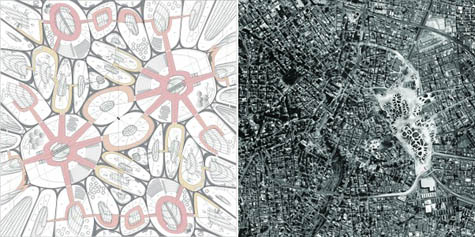 [Images: Two projects from the Hinterlands exhibition: (left) MatArc by Patrick Usborne, (right) Crackology by Mayhem]. [Images: Two projects from the Hinterlands exhibition: (left) MatArc by Patrick Usborne, (right) Crackology by Mayhem].Information about venue, timing, tickets, and more can all be found on the conference website.
 This weekend in Lund, Sweden, Sir Peter Cook and Abelardo Gonzalez will be hosting the 2009 ASAE conference, the theme of which is Communicating Architecture. ASAE is an annual symposium at the School of Architecture, Lund University, Sweden. It celebrates the beginning of the academic year. This year's ASAE will be a two-day event with lectures, seminar, critique, exhibition and more. I'm still pretty stunned to find myself listed as a speaker, alongside people like Thom Mayne, Odile Decq, and Hernan Diaz Alonso; but I'm also excited by the opportunity to bring blogs again into this sort of organized discussion. Unfortunately, I'll be speaking first thing Saturday morning! But I'll be giving a talk called "Optioning Architecture." There will be at least two major themes to be developed: 1) What are the options available to architects when it comes to communicating spatial ideas? Are renderings, plans, and diagrams still the most communicationally effective media to use (from the perspective of the interested public) or simply the most industrially useful (from the perspective of fellow architects and contractors)? What happens when, say, Bernard Tschumi's next building is not announced to the public via well-rendered images and a press release but in the form of a novel? There is also much to discuss here by inverting this scenario and asking: what happens when novelists, screenwriters, poets, and so on begin creating buildings to communicate their literary and narrative ideas, instead of producing texts? While this obviously risks repeating the textualist arguments of an earlier decade, it still seems worth asking what might have happened if James Joyce, for instance, had been a junior architect at KieranTimberlake: what effect might his literary urges have had upon that firm's built output? Put another, slightly cheesy, way: if Mervyn Peake had been a successful architect, what strange and sprawling manor houses might now exist somewhere in the English countryside? In any case, what, in the end, are the communicational options available to architects?  2) What possibilities exist for "optioning architecture," in the sense that a book, short story, or screenplay can be "optioned" by Hollywood for production in another media? That is, what might happen to the world of architectural design if your final graduate thesis project was to be optioned by Steven Spielberg or David Fincher? Would this be similar, in some ways, to the relationship between Rem Koolhaas's co-authored graduate thesis project, "Exodus, or the Voluntary Prisoners of Architecture," and Rupert Thomson's under-appreciated novel Divided Kingdom? To what extent is the latter a novelization of the former? Finally, would it be possible for someone from DreamWorks to come along, see a new museum under construction in Chicago or Baltimore, and then option it, the way he or she might option a promising novel? Could you literally translate the spatial dynamism and implied narrative logics of a building – could you option them – into an act of mainstream cinema? How might such a process work – and is there a reason why this hasn't yet occurred (i.e. it would be a totally ridiculous thing to do)? Of course, there are other types of architectural options that we could discuss here – but I'll be focusing on the two ideas described above. The complete conference line-up includes Florencia Pita, David Garcia, Drura Parrish, Megumi Matsubara, and Daniel Golling. Read more on the conference blog.
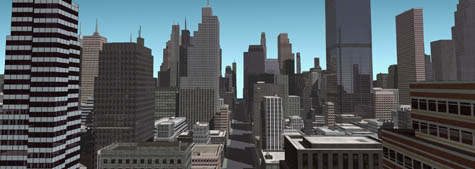 [Image: From Procedural Modeling of Cities by Yoav Parish and Pascal Müller].Note: This is a guest post by Jim Rossignol. [Image: From Procedural Modeling of Cities by Yoav Parish and Pascal Müller].Note: This is a guest post by Jim Rossignol.In 2001 Yoav Parish and Pascal Müller spoke at the SIGGRAPH conference in Los Angeles, California, to present a mathematical city. Their presentation contained an algorithmic approach for modeling city-like topologies. The results were remarkably realistic, and were one among a host of city-like generative systems to appear at the start of the decade. Another, Jared Tarbell's Substrate (pictured) remains a fantastic example of how a mathematical approach to generating apparently urban patterns can also be artful. 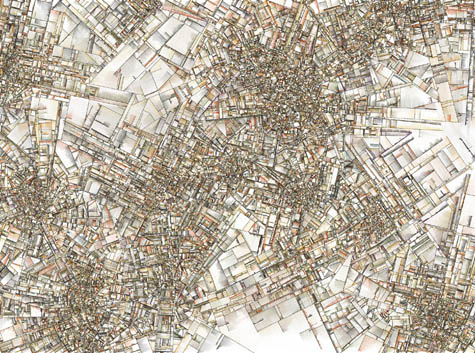 [Image: From Jared Tarbell's Substrate]. [Image: From Jared Tarbell's Substrate].But it was looking at the work of Parish and Müller that inspired game designer Chris Delay to develop his most recent project: the cryptic (and as-yet-unexplained) Subversion, of which little is known, other than it relies on large, procedurally generated cities for the backbone of its game world. Having already been burned by the problems of creating content "by hand," Delay set out to let algorithms do the work of building buildings in his new game. Not only that, but he was determined to create an artistically interesting experience without artists. 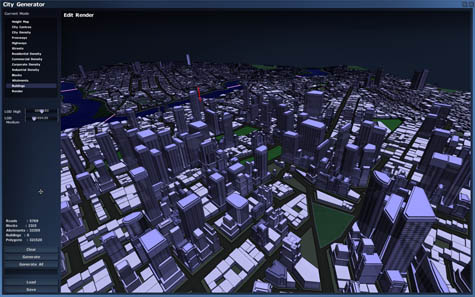 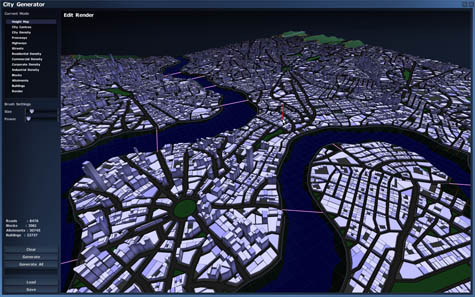 [Images: From Chris Delay's Subversion]. [Images: From Chris Delay's Subversion].Of course, videogames have long been the home of procedurally generated landscapes where numbers and mathematical equations played the role of the visual designer. Early paranoid classic The Sentinel made use of these techniques to create an astonishingly atmospheric 10,000 levels in simple vector graphics, from just a few kilobytes of data. Other games have used similar techniques as a shortcut to creating solar systems and vast fractal landscapes. But when it came to cities, well, it took a long time for anyone to take up the challenge. 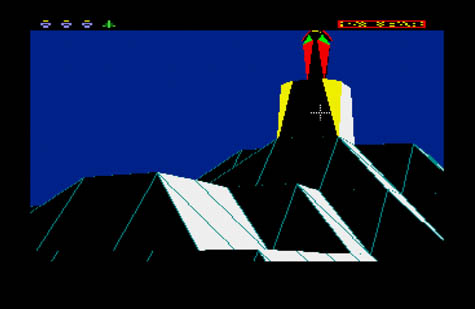 [Image: From The Sentinel by Geoff Crammond]. [Image: From The Sentinel by Geoff Crammond].Rather than opt for procedural techniques, game designers usually elect to build their cities by hand, often with startling results. The re-imagined contemporary New York that features in last year's Grand Theft Auto 4 required a small army of well-paid artists and designers to hand-craft the entire world. Their accomplishment is unmatched, but the cost to the company behind the project is in the tens—and perhaps hundreds—of millions of dollars. To build up a living city from blank polygons is one of the most expensive possible projects in game design. Delay, whose project is being undertaken with a tiny budget and by just a handful of staff based in Cambridge, UK, does not have the luxury of vast content teams. His vector-drawn city is far less realistic than Rockstar's textured, heaving metropolis, but there's nevertheless a beauty to it. It's a kind of mathematical map of the essential urban environment: there are roads, sidewalks, and a no-man's land of corporate moats around great skyscrapers... Identify the key equation that define urban patterns, and you, too, can summon a city into existence. Delay has begun to show off how his cities emerge from the ground up in a series of videos, and he spoke to me about the process. "I started out with road layouts, and then began to modify the parameters," he explained. "Sometimes you'll get lovely radial, spiral patterns, or you can tell it to create a really rigid Manhattan-style grid." One set of numbers delivers the block logic of American cities, another is rather more like the spirals of Medieval European sprawls. The two merge to create something even more believable. "Every subsequent layer builds on the previous layer," Delay points out, "so the very next layer looks for the spaces between layers, and makes judgments about 'is this likely to be a skyscraper, or to be a house?' Then you zoom in, and carry on. You do another procedural generation process for each layer of detail, filling in that world." 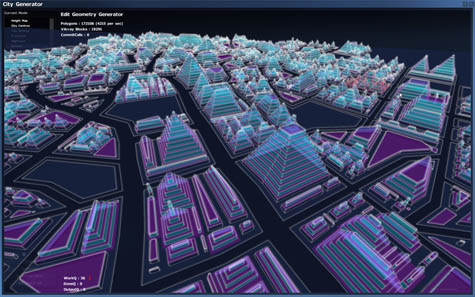 [Image: From Chris Delay's Subversion]. [Image: From Chris Delay's Subversion].A few weeks after speaking with Delay I attended Thrilling Wonder Stories—a seminar at the Architectural Association in London, curated by Liam Young and BLDGBLOG—where I watched conceptual designer Viktor Antonov explain how he had created a science-fictionalized Paris (for a now-cancelled videogame called The Crossing). Antonov approached the problem by altering just a few parameters in the standard architectural model. For instance, Antonov had noticed a few fundamental details about how the mid-nineteenth century neo-classical core of Paris had been constructed: big street-level floors, smaller attic spaces, complex chimney stacks. By increasing the emphasis on the lower floors, and stretching them out—and by emphasizing the height and complexity of the chimneys—Antonov was able to create a thematically consistent science fiction Paris. Simply by altering a few basic architectural parameters, he said, you were able to fictionalize the city, whilst at the same time retaining its fundamental identity. His designs were still recognizably—even mathematically—Parisian, in other words, but they were also otherworldly.  [Image: By Viktor Antonov]. [Image: By Viktor Antonov].This idea instantly connected back to Delay's project: what parameters would we need in order both to understand and create a science fiction Edinburgh, or Sao Paulo, or Vancouver? Identify the necessary fantasy logic within a procedural city-building system and you could recreate cities with their alternate identity in an instant. An accelerated future Moscow, or a retropunk Venice, instantly sprawling out of the monitor. And perhaps this is not such an outlandish thing to aim for—especially when you consider the speed at which procedural city projects have been appearing across the tech landscape. Could one of these cities potentially be refitted to allow for this type of radical tweak? Projects like Shamus Young's impressive PixelCity, or Marco Corbetta's Structure seem ripe for such strange fictions. Corbetta's system is particularly impressive in its verisimilitude: he aims to create a basic engine for rapidly generating the kinds of cities that games like Grand Theft Auto 4 require, and consequently doing so for much cheaper. Could Corbetta's engine come with a Paris or a Barcelona preload, which could then be put through Photoshop-style filters for alternate reality logic in its architecture? A stronger skyline, weirder street furniture. 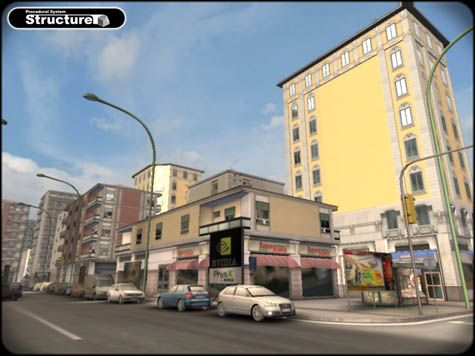 [Image: From Marco Corbetta's Structure]. [Image: From Marco Corbetta's Structure].More exciting, at least for the thrill-seeking gamer in me, is the fact that Corbetta is aiming one notch higher than any of his peers: he's aiming to make these cities procedurally destructible. His site contains a demonstration video of neatly arrange office interiors and a domestic library being blown to pieces with a machine-gun. What good is an imaginary city if you can't go inside the buildings? What good is a virtual downtown if you can't go crazy with a bazooka? Corbetta's work preempts these questions. Further, it conjures visions of massive demolition exercises in parallel worlds—entering an Antonov-algorithm for neo-Rome, where gladiatorial escapades see us going through the walls of the coliseum and into the randomly generated plazas beyond. That, perhaps, is the greatest promise of procedural cities: that soon they'll be real enough that their destruction will seem like tragedy. [Jim Rossignol is a games critic for Offworld, an editor at Rock, Paper, Shotgun, and the author of the fantastic This Gaming Life: Travels in Three Cities. A full-length interview with Rossignol appeared on BLDGBLOG in May, and he has written a previous guest post, Evil Lair: On the Architecture of the Enemy in Videogame Worlds].
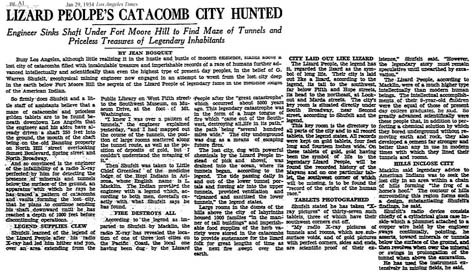 [Image: View larger]. [Image: View larger].Last week, Josh Williams, formerly of Curbed LA, emailed with an amazing link to an article, reportedly published back in 1934 by the L.A. Times, about a race of "lizard people" who once lived beneath the city. "Did strange people live under site of Los Angeles 5000 years ago?" the article asks, supplying a bizarre treasure map through the city's undersides in the process. 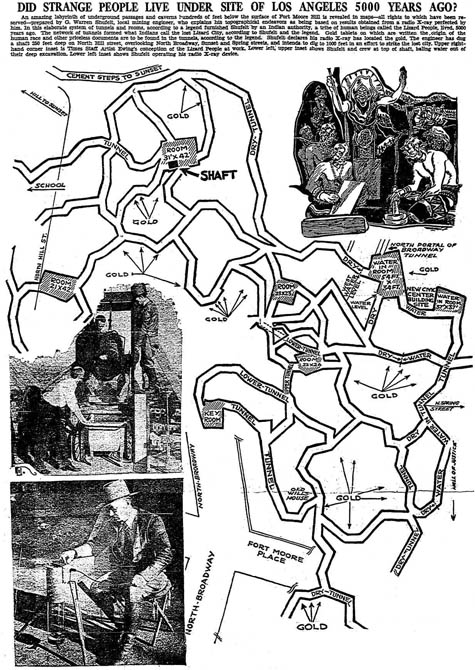 [Image: View larger]. [Image: View larger].Although you can read the article in full through these links, I wanted to give you a taste of the story's strange mix of gonzo archaeology, Poltergeist-like pre-Columbian cultural anxiety, and start-up geophysical investigation squad: So firmly does [a "geophysical mining engineer" named G. Warren Shufelt] believe that a maze of catacombs and priceless golden tablets are to be found beneath downtown Los Angeles that the engineer and his aides have already driven a shaft 250 feet into the ground, the mouth of the shaft behind on the the old Banning property on North Hill Street overlooking Sunset Boulevard, Spring Street and North Broadway.
And so convinced is the engineer of the infallibility of a radio X-ray perfected by him for detecting the presence of minerals and tunnels below the surface of the ground, an apparatus with which he says he has traced a pattern of catacombs and vaults forming the lost city, that he plans to continue sending his shaft downward until he has reached a depth of 1000 feet before discontinuing operations. The article goes on to suggest that this ancient subterranean city was "laid out like [a] lizard"; we visit a Hopi "medicine lodge," wherein geophysical secrets are told; there are lost gold hoards; and, all along, the engineer's "radio X-ray" apparatus continues to detect inhabitable voids beneath the metropolis. "I knew I was over a pattern of tunnels," Shufelt is quoted, "and I had mapped out the course of the tunnels, the position of large rooms scattered along the tunnel route, as well as the position of the deposits of gold, but I couldn't understand the meaning of it." Perhaps this is what we'd get if Steven Spielberg hired Mike Mignola to write the next installment of Indiana Jones. (Thanks to Josh Williams, and to vokoban, who originally uploaded the scan. Vaguely related: The Hollow Hills and Mysterious Chinese Tunnels).
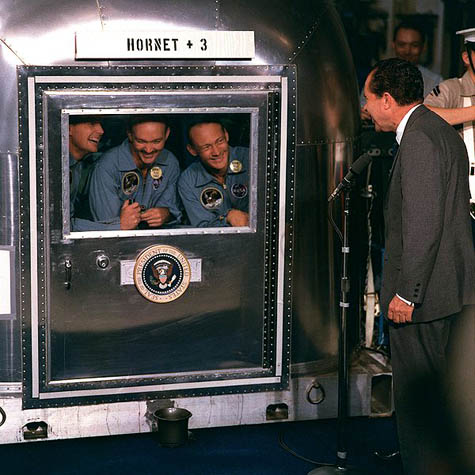 [Image: President Nixon addresses quarantined astronauts from the Apollo program; via NASA]. [Image: President Nixon addresses quarantined astronauts from the Apollo program; via NASA].I'm incredibly excited to announce not only that BLDGBLOG will be living in New York City this fall, but that my wife and I will be hosting a design studio there called Landscapes of Quarantine – the results of which will be the subject of a public exhibition at Storefront for Art and Architecture in early 2010. Meeting one evening a week this autumn in Manhattan, from October 6 to December 5, 2009, up to 14 studio participants will discuss the spatial implications of quarantine, each developing an individual design project in response to the studio theme. Quarantine is both an ancient spatial practice and a state of monitored isolation, dating back at least to the Black Death – if not to Christ's 40 days in the desert – yet it has re-emerged today as an issue of urgent biological, political, and even architectural importance in an era of global tourism and flu pandemics.  [Image: "Fear of Flu" by Mike Licht]. [Image: "Fear of Flu" by Mike Licht].Quarantine touches on serious constitutional issues associated with involuntary medical isolation, as well as on questions of governmental authority, regional jurisdiction, and the limits of inter-state cooperation. Quarantine is as much a matter of national security, public safety, and agricultural biodiversity as it is an entry point into discussions of race, purity, and unacknowledged discrimination. Quarantine is also a plot device increasingly seen in novels and films – from the aptly named Quarantine and Albert Camus's The Plague to I Am Legend and The Last Town on Earth – even as it has become a source of arcane technical debate within plans for Martian exploration and Antarctic drilling rights. The design implications of quarantine stretch from the ballast water of ships to the way we shape our cities, from the clothes in travelers' suitcases to stray seeds stuck in the boot treads of hikers. Quarantine affects the pets we keep, the programs we download, and the machines we use in food-processing warehouses, worldwide. Quarantine is about managing perimeters, controlling influence, and stopping contamination. 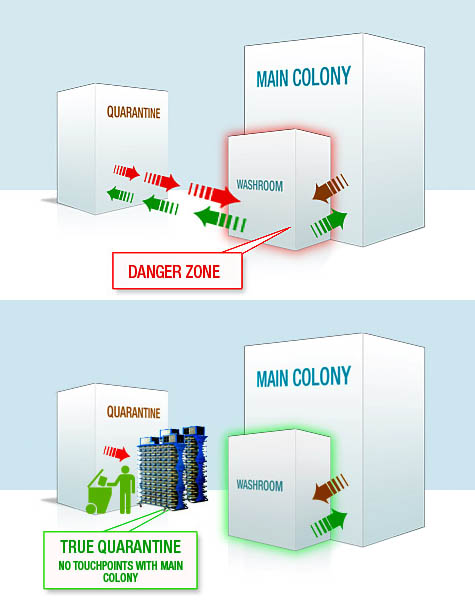 [Image: Cages for the laboratory testing of rats and mice by Innovive]. [Image: Cages for the laboratory testing of rats and mice by Innovive].So how do we treat quarantine as a design problem? Whether we design something to demonstrate that the very notion of quarantine might not be possible; whether we produce actionable plans for quarantine units, ready for implementation by the World Health Organization in hot zones around the world; whether we create quarantine-themed graphic novels, barrier-based urban games, or a series of ironic public health posters to be mounted around the city, how can we design for quarantine? Quarantine also offers fertile territory for investigation through cartography and cultural documentation. After all, if we mapped the contents and locations of quarantine facilities worldwide, designed infographics to analyze the spread of invasive species, or recorded the oral histories of the quarantined, what sorts of issues might we uncover? Bringing these very different techniques, media, and approaches together in the confines of a dedicated design studio will give participants an exciting opportunity to explore the overlooked spatial implications of quarantine.  [Image: A poster for Quarantine, directed by John Erick Dowdle]. [Image: A poster for Quarantine, directed by John Erick Dowdle].We have already confirmed a fantastic list of participants, whose backgrounds include architecture, photography, illustration, games design, sound, landscape, food, and more; we are now opening the studio to a general call for interested participants. The brief – which you can download here as a PDF or that you read as a JPG on Flickr – explains more; but potential applicants will be working with a truly stellar group as they meet once a week this fall and produce work eligible for inclusion in the "Landscapes of Quarantine" exhibition to be held at Storefront for Art and Architecture in early 2010. If you are interested, please download the brief – which includes all necessary application info – and contact us at futureplural @ gmail by September 19, 2009.  [Image: Australian quarantine signage]. [Image: Australian quarantine signage].For ease of reference, I have decided to include the studio brief in full below: Landscapes of Quarantine is an independent, multi-disciplinary design studio, based in New York City, consisting of eight Tuesday evening workshops, from October 6 to December 5, 2009, in which up to 14 participants will gather to discuss the spatial implications of quarantine. Quarantine is an ancient spatial practice characterized by a state of enforced immobility, decontamination, and sequestration; yet it is increasingly relevant—and difficult to monitor—in an era of global trade, bio-engineering, and mass tourism.
Studio participants will explore a wide variety of spatial and historical examples, including airport quarantine facilities, Level 5 biohazard wards, invasive species, agricultural regulations, swine-flu infected tourists confined to their hotel rooms, lawsuits over citizens' rights to resist involuntary quarantine, horror films, World Health Organization plans for controlling the spread of pandemics, lunar soil samples, and more.
During the studio, participants will develop individual design projects in response to the problem of quarantine, with guidance and inspiration provided by readings, screenings, group discussions, and an evolving line-up of guest speakers and critics. These projects will then be eligible for inclusion in "Landscapes of Quarantine,” an exhibition hosted by the internationally renowned Storefront for Art and Architecture in early 2010.
By the end of the studio, each participant will have produced a complete design project. This could range from the speculative (plug-in biosecurity rooms for the American suburbs) to the documentary (recording the items and animals detained for quarantine on the U.S./Mexico border), and from the fantastical (plans for extra-planetary quarantine facilities) to the instructional (a field guide to invasive species control).
Landscapes of Quarantine is looking for applicants who are intrigued by the spatial possibilities and contingencies of quarantine, and who already possess the technical skills necessary to produce an exhibition-quality final design project or installation in their chosen medium. We hope to hear from people at all stages of their careers—from graduate school to retirees—and from a wide variety of design backgrounds. We are particularly excited to announce that we have already confirmed a select group of talented participants from fields as diverse as architecture, illustration, gaming, photography, and sound design.
The studio is both unaffiliated and independent (there is no college credit), and it is also free (though applicants will be responsible for all costs associated with producing their final project). We will be reviewing applications on a rolling basis until Friday, September 18, 2009, or until all studio positions have been filled. To learn more, and to submit an application, please email futureplural @ gmail with the information listed below.
1) Name
2) Email address
3) Telephone number(s)
Please indicate the best time to reach you
4) Mailing address
5) Education
• University/college name and country
• Dates attended
• Degree
6) Current affiliations and/or employment
7) 50-word (maximum) bio
8) Publications and/or personal blog
9) Portfolio
Attach a PDF of no more than 8 pages, or supply a link to online work
10) 300-word (maximum) statement of interest in the topic of quarantine
11) Candidate’s declaration
By submitting your application, you declare the following:
• I certify that the work submitted is entirely my own and/or my role is clearly stated
• I declare that all the statements I have provided are correct
• I agree that, if accepted into the studio, I will participate fully, attend all studio meetings unless previously discussed with the studio directors, and produce a finished final design project
12) Email addresses for two references
Landscapes of Quarantine is produced and organized by Future Plural, a project-based, independent design lab launching in October 2009 from a temporary base in New York City. Future Plural is Geoff Manaugh (BLDGBLOG) and Nicola Twilley (Edible Geography). Finally, a major motivation behind starting Future Plural and hosting the Landscapes of Quarantine studio is to found a new institution without permanent location, dependence on grants, or academic affiliation. After all, as bloggers, why can't we create our own groups, faculties, cultural spaces, and more? By bringing people together, on a project-by-project basis, to explore ideas and issues in a cross-disciplinary environment, we hope to demonstrate that, even in a time of recession, there is a broadly shared enthusiasm for creating something new.
Amongst the huge stacks of reading material that I always seem to accumulate, even while traveling, I have just picked up a copy of Philip Parker's new book The Empire Stops Here. In a nutshell, the book documents Parker's epic tour around the former edge of the Roman empire, "visiting all its astonishing sites, from Hadrian's Wall in the north of Britain to the desert cities of Palmyra and Leptis Magna," the book jacket explains. We're reminded that "the Empire guarded and maintained a frontier that stretched for 10,000 kilometres, from Carlisle to Cologne, from Augsburg to Antioch, and from Aswan to the Atlantic." So why not explore the whole thing? 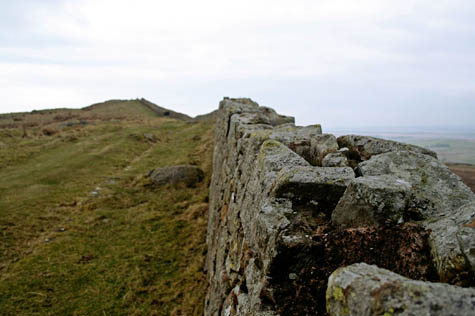 [Image: Hadrian's Wall]. [Image: Hadrian's Wall].On page one Parker writes that "I have concentrated deliberately on the edge of the Roman world, on the lands that promised victory, booty and glory and yet so often left the bitter taste of compromise or defeat instead. Here, unique societies developed, distinct from that of the mother-city" – frontier micro-cultures amidst border country that, even today, remains populated with architectural and anthropological evidence of these long-ago evaporated Roman outposts. Outpost tourism, perhaps. Edge-traveling. It would be a curious project, indeed, to try something similar for a nation-state today, when borders are often fluid and even exportable. In fact, I'm reminded of a plan to "take the UK border overseas," as the Times reported last year, dematerializing the actual national border and replacing it with a series of offices and points of entry maintained far away in the country of origin. Right when you think you've found the perimeter of Britain, it's relocated yet further away, pushed to an airfield or embassy two thousand miles in the distance. How interesting would it be to set out to explore the edge of a country – only to be unable to find it? China Miéville meets Tlön by way of the UK Border Agency. For now, Parker's book only seems to be available in the UK – but I've got high hopes for it and plan to report back as I read further. You can listen to a brief interview with the author here.
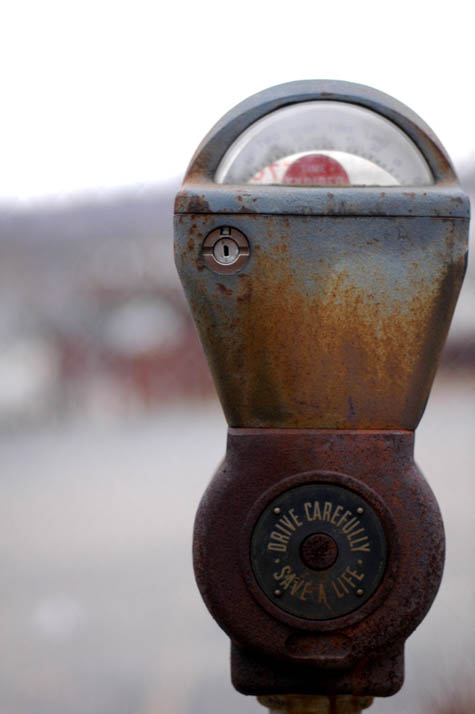 [Image: A parking meter photographed by shooting brooklyn, via a Creative Commons license]. [Image: A parking meter photographed by shooting brooklyn, via a Creative Commons license].A story I missed earlier this summer reports that Oakland, California, is making up for falling tax revenue by " aggressively enforcing traffic violations." The decision is driven by the city's budget woes, which deep cuts to city services alone did not solve. Falling sales and property, property transfer and hotel taxes have contributed to a $51 million decline in revenues. It's worth asking, though, whether paying "aggressively" increased fees and fines for our everyday use of the city – whether this means road tolls and garbage collection fees or suddenly unaffordable parking meters – is the best financial model for a post-taxation metropolis. Put another way, if the ongoing recession has revealed, amongst other things, that a new type of city, run along very different financial lines, looms just weeks away – a kind of make-your-own-omelette city of fines, fees, and services, where every ingredient is individually priced – then perhaps the recession might also stimulate a wider debate about what could be called method of payment. That is, what method of payment do we wish to use when it comes to living in a functioning metropolis? If we find ourselves paying no tax at all, for instance – no income tax, no sales tax, no property tax – would we be happy to pay parking tickets that hit upper limits of, say, $2000 or more each time, if this is what it takes to keep the city running? Conversely, would we be happy to pay more sales tax in order to avoid things like road tolls altogether? How exactly do we mix and match these urban outlays and receipts? This would seem to cut to some of the most basic questions of what services constitute a city in the first place: what a government might provide and how it is that we will pay for what it offers. In a distant way, and by means of a long digression, I'm reminded of the oft-repeated idea that nationalized health care would be a mere "hand-out," not a central platform of what any government might do to protect its citizenry. For instance, one man at a recent but quite bizarre anti-health care rally – during which a U.S. senator apparently praised this very man for his publicly announced support of terrorism – said that "he could trace his ancestors back to the Mayflower and said 'they did not arrive holding their hands out for help.'" Ergo, this man should not "hold out his hands for help" and ask the government for a doctor's visit. Of course, this same argument would surely never be advanced against, say, calling the police, calling the fire department, or accepting the defense of the U.S. military. Yet these are all tax-funded government services. The bizarre irony for me throughout all of this has been that police officers, fire crews, and members of the military are all, to use this language very deliberately, the most socialized subsector of the U.S. economy. That is, they are paid through what many people would call "government hand-outs." On the other hand, it is these very social positions that are often held up – by these same critics – as triumphant examples of national service and personal heroism. Indeed, it is not entirely inaccurate to say that The Greatest Generation was a generation of near-total tax-funded employment. If the recent health care debates are to be believed, doctors are not subject to this same sense of national appreciation; they are mysteriously yet fundamentally unlike the police, we are meant to believe, offering services that only private money can afford. But where is the line between private health (diabetes) and public safety (tuberculosis) – and when might this solidify into actual government infrastructure? Doctors are not like the tax-funded fire departments who we freely call to save us from wildfires, this logic goes, and they are quite unlike the government-supported soldiers who we have stationed in Iraq, Afghanistan, and elsewhere. Surely, then, anyone who relies on the U.S. military to protect them is "holding their hands out for help"? In this context, it's worth speculating what might happen today if fire departments had, until now, been entirely privatized, motivated to protect you only if your insurance policy was up to date (as, indeed, was the case with the first urban fire departments, and as is now re-emerging in places like California). What would be the reaction, then, if someone proposed that these services be folded into a more general package of government services? If fire crews, in this model, suddenly became tax-funded and available to all citizens – indeed socialized as part of a shared, city infrastructure – would there be the same level of outrage? One wonders if fire crews might ever attain the entirely deserved levels of public adulation they now receive, if their tax-funded nature was, once and for all, revealed. Protesting citizens, like the gentleman cited above, might never have the stomach to "ask for help" from the government, even if their houses are burning down around them. In any case, I mention all this because of the urgency with which we need to rethink the world of urban services and the economic basis through which we pay for them. If the tax system, as it is currently operated, cannot pay for the very activities that we once thought synonymous with urbanity, are radical increases in one-off fees a permanent, economically viable solution to this problem or simply an irritating and only mildly effective band-aid? Is it better to pay more, once a year, in order to avoid such fees altogether? Further, how are we best to judge the effectiveness of increased fines and pay-as-you-go services: by the psychological sense of irritation that a penalty-based system might cause – I'm reminded of parking attendants required to wear bulletproof vests during streetwork – or by the comfort that a lack of taxes might provide? Or, more measurably, do we judge them by their physical effect on the city? (Original article spotted via the denialism blog).
 [Image: "Lightning Bugs in York, PA," by tom.arthur, courtesy of a Creative Commons license]. [Image: "Lightning Bugs in York, PA," by tom.arthur, courtesy of a Creative Commons license].
While traveling last week, I managed to re-read W.G. Sebald's book The Rings of Saturn. At one point, Sebald describes two entrepreneurial scientists from the 19th century, who he names Herrington and Lightbown; together, we're told, they had wanted to capture the bioluminescent properties of dead herring and use that as a means of artificially illuminating the nighttime streets of Victorian London. Sebald writes: An idiosyncrasy peculiar to the herring is that, when dead, it begins to glow; this property, which resembles phosphorescence and is yet altogether different, peaks a few days after death and then ebbs away as the fish decays. For a long time no one could account for this glowing of the lifeless herring, and indeed I believe that it still remains unexplained. Around 1870, when projects for the total illumination of our cities were everywhere afoot, two English scientists with the apt names of Herrington and Lightbown investigated the unusual phenomenon in the hope that the luminous substance exuded by dead herrings would lead to a formula for an organic source of light that had the capacity to regenerate itself. The failure of this eccentric undertaking, as I read some time ago in a history of artificial light, constituted no more than a negligible setback in the relentless conquest of darkness. Sebald goes on to write, elsewhere in the book, that, "From the earliest times, human civilization has been no more than a strange luminescence growing more intense by the hour, of which no one can say when it will begin to wane and when it will fade away." But it's the idea that we could use the bioluminescent properties of animals as a technique of urban illumination that absolutely fascinates me. In fact, I'm instantly reminded of at least three things: 1) Last month I had the pleasure of stopping by the Architectural Association's year-end exhibition of student work. As part of a recent studio taught by Liam Young and Kate Davies – which, incredibly, included a field trip to the Galapagos Islands – a student named Octave Augustin Marie Perrault illustrated the idea of a "bioluminescent bacterial billboard." From the project text: "A bioluminescent bacterial billboard glows across the harbour... We are constantly reminded of the condition of the surrounding environment as the bio indicators becomes an expressive occupiable ecology."
 [Image: Bioluminescent billboards on one of the Galapagos Islands, by Octave Perrault]. [Image: Bioluminescent billboards on one of the Galapagos Islands, by Octave Perrault].
In many ways, Perrault's billboards would be a bit like the River Glow project by The Living... only it would, in fact, be illuminated by the living. These bioluminescent bacteria would literally be a living window onto a site's environmental conditions (or, of course, they could simply be used to display ads). Liam Young, the studio's instructor, has also designed a version of these bioluminescent displays, casting them more fantastically as little creatures that wander, squirrel-like, throughout the city. They pop up here and there, displaying information on organic screens of light.
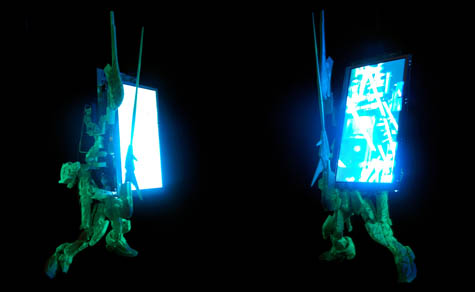 [Image: Bioluminescent billboards by Liam Young]. [Image: Bioluminescent billboards by Liam Young].
I'm genuinely stunned, though, by the idea that you might someday walk into Times Square, or through Canary Wharf, and see stock prices ticking past on an LED screen... only to realize that it isn't an LED screen at all, it is a collection of specially domesticated bioluminescent bacteria. They are switching on and off, displaying financial information. Or you're watching a film one night down at the cinema when you realize that there is no light coming through from the projector room behind you – because you are actually looking at bacteria, changing their colors, like living pixels, as they display the film for all to see. Or: that's not an iPod screen you're watching, it's a petri dish hooked up to YouTube. This is what I imagine the world of screen displays might look like if Jonathan Ive had first studied microbiology, or if he were someday to team up with eXistenZ-era David Cronenberg and produce a series of home electronic devices. Our screens are living organisms, we'll someday say, and the images that we watch are their behavior.
2) As I mentioned in an earlier post, down in the Blue Mountains of New South Wales is a tunnel called the Newnes Glow Worm Tunnel. It is a disused railway tunnel, bored through mountain sandstone 102 years ago, that has since become the home for a colony of glow worms. As that latter link explains: "If you want to see the glow worms, turn off your torch, keep quiet and wait a few minutes. The larvae will gradually 'turn on' their bioluminescence and be visible as tiny spots of light on the damp walls of the tunnel." 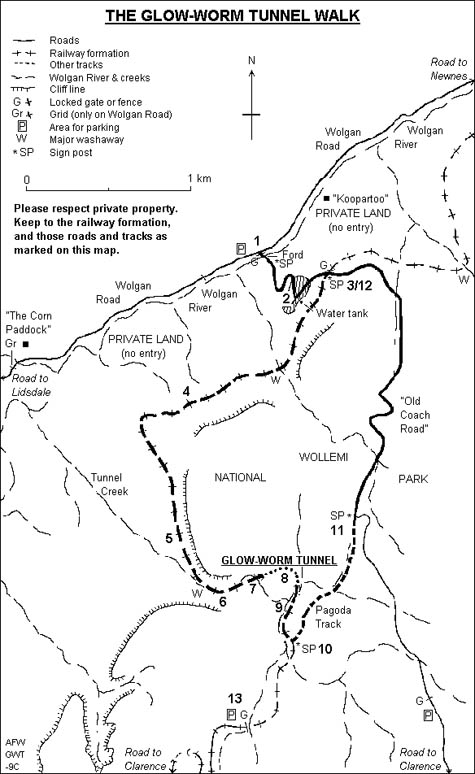 [Image: A map of the Glow Worm Tunnel Walk, New South Wales]. [Image: A map of the Glow Worm Tunnel Walk, New South Wales].
Incorporate this sort of thing into an architectural design, and it's like something out of the work of Jeff VanderMeer – whose 2006 interview here is still definitely worth a read. I'm picturing elaborate ballrooms lit from above by chandeliers – in which there are no lightbulbs, only countless tens of thousands of glow worms trapped inside faceted glass bowls, lighting up the faces of people slow-dancing below. Or perhaps this could have been submitted to Reburbia: suburban houses surviving off-grid, because all of their electrical illumination needs are met by specially bred glow worms. Light factories! Or, unbeknownst to a small town in rural California, those nearby hills are actually full of caves populated only by glow worms... and when a midsummer earthquake results in a series of cave-ins and sinkholes, they are amazed to see one night that the earth outside is glowing: little windows pierced by seismic activity into caverns of light below.
3) Several years ago in Philadelphia, my wife and I went out for a long evening walk, and we sat down on a bench in Washington Square Park – and everything around us was lit by an almost unbelievable density of fireflies, little spots of moving illumination passing by each other and overlapping over concrete paths, as they weaved in and out of aerial formations between the trees. But what if a city, particularly well-populated with fireflies (so much more poetically known by their American nickname of lightning bugs) simply got rid of its public streetlights altogether, being so thoroughly drenched in a shining golden haze of insects that it didn't need them anymore? You don't cultivate honeybees, you build vast lightning bug farms. How absolutely extraordinary it would be to light your city using genetically-modified species of bioluminescent nocturnal birds, for instance, trained to nest at certain visually strategic points – a murmuration of bioluminescent starlings flies by your bedroom window, and your whole house fills with light – or to breed glowing moths, or to fill the city with new crops lit from within with chemical light. An agricultural lightsource takes root inside the city. Using bioluminescent homing pigeons, you trace out paths in the air, like GPS drawing via Alfred Hitchcock's The Birds. An office lobby lit only by vast aquariums full of bioluminescent fish! Bioluminescent organisms are the future of architectural ornament.  [Image: A bioluminescent tobacco plant, via Wikivisual]. [Image: A bioluminescent tobacco plant, via Wikivisual].
On the other hand, I don't want to strain for moments of poetry here, when this might actually be a practical idea. After all, how might architects, landscape architects, and industrial designers incorporate bioluminescence into their work? Perhaps there really will be a way to using glowing vines on the sides of buildings as a non-electrical means of urban illumination. Perhaps glowing tides of bioluminescent algae really could be cultivated in the Thames – and you could win the Turner Prize for doing so. Kids would sit on the edges of bridges all night, as serpentine forms of living light snake by in the waters below. Perhaps there really will be glowing birds nesting in the canopies of Central Park, sound asleep above the heads of passing joggers. Perhaps the computer screen you're reading this on really will someday be an organism, not much different from a rare tropical fish – a kind of living browser – that simply camouflages new images into existence. Perhaps going off-grid will mean turning on the lifeforms around us.
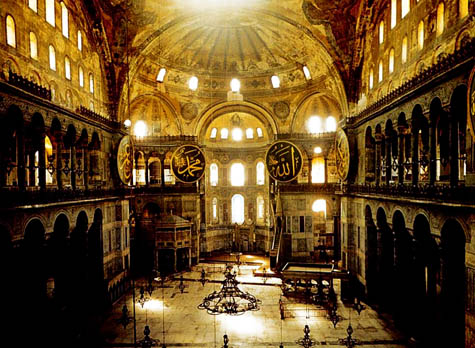 [Image: Inside Hagia Sophia; via]. [Image: Inside Hagia Sophia; via].While scuba diving beneath Hagia Sophia, an exploratory team led by filmmaker Goksel Gülensoy has "managed to reach areas that until now, no one had ever managed to reach," down there in flooded basins 1000 feet beneath Istanbul's heavily touristed religious structure. In the process, they have discovered 800-year old submerged graves containing the remains of "canonized children." This was just part of a larger, underwater archaeo-spatial survey: The divers and specialists explored the connection of the basins underneath Aghia Sophia with the aqueduct and the palace of Top Kapi. In addition they attempted to locate the secret tunnels from Tekfour Palace to the Islands. Those "secret tunnels" are presumably the rumored subterranean extensions of the Anemas Dungeons – but who knows. Either way, I have long been fascinated by the idea of scuba diving beneath – if not actually through – architectural structures, so I am definitely looking forward to watching Gülensoy's forthcoming documentary about these discoveries. That film, appropriately enough entitled In the Depths of Hagia Sophia, will begin screening at film festivals this autumn. "I believe what is beneath Hagia Sophia is much more exciting than what is above the surface," Gülensoy explained to the Hürriyet Daily News and Economic Review. There, we read about the flooded basins in more detail: Years ago, Erdem Yücer, one of the former directors of the museum, had shown Gülensoy a photograph that was taken of the foundations of Hagia Sophia. The photo showed researchers in a boat in a place filled with water, resembling the Yerebatan Cisterns. Seismic research had also demonstrated that the area underneath the big hall was empty. The team, which had previously lowered a camera down from the second door during the first exploration, was thrilled to see two passages extending to the center of the building and to the exit door – passages that might extend to Yerebatan and Topkapi. For somewhat obvious reasons, I'm reminded of the " huge underground lake" discovered underneath Budapest late last year. "Budapest is built above a maze of unexplored underground caves," The Sun reported at the time. In any case, the Hürriyet article includes short descriptions of the actual tunnels beneath Hagia Sophia, and it mentions plans for these otherwise archaeologically unknown spaces to be scanned for later study. This latter detail reminds me of the Bill Stone video that I linked a few days back. (With thanks to John Maas! Vaguely related: recreational fishing in the basements of Manhattan).
Having arrived back in London to another massive stack of books, magazines, and other architectural publications – including one-off broadsides, pamphlets, and even a deck of urban-themed playing cards – I've been immersed in a sea of mind-bending spatial ideas. This morning, I've been specifically thinking about the publication of student work, as I've (finally) been able to read through a recently published catalog of the Bartlett School of Architecture's 2009 school year. 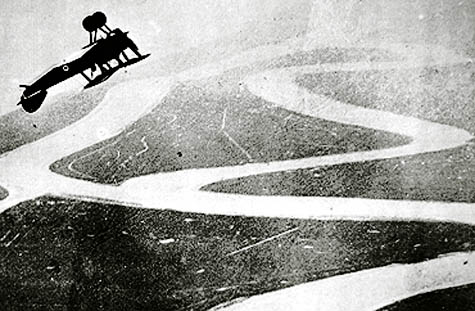 [Image: From Unit 23 at the Bartlett, taught by Bob Sheil and Emmanuel Vercruysse]. [Image: From Unit 23 at the Bartlett, taught by Bob Sheil and Emmanuel Vercruysse].The book includes some amazing imagery and ideas – from a cantilevered "salt spa," by Janinder Bhatti, partially held up on shadow-casting stilts, to a "sailing school" proposed for a trans-continental urban site on the Bosphorus by Nicholas Elias, by way of a "landfill tower" for Manhattan designed by Gabriel Chung. There are two entirely separate designs for blood banks (one in Brooklyn by Stefano Passeri and one on the U.S./Mexico border by Victor Hadjikyriaki); there are the extraordinary-sounding "archaeological prosthetics for the Schliemann excavations of Troy" by Fei Meng; there is an ingenious pitch for a "South African Land Registry and Claims Court," in the guise of exploring "political geology," by Joshua Scott; there is a "dissolvable pavilion" by Snow Cai, a "Museum of Dust" by Olivia Pearson, and a "Roosevelt Island Respiratory Clinic" by Chiara Montgomerie, all from Unit 8, taught by Johan Berglund and Rhys Cannon; there is a "flower therapy institute" by Sandra Youkhana; and there is something that I am dying to know more about, called "Pioneering Weather" by Martin Tang. This latter project appears to be a kind of nuclear-powered sky-alteration device, complete with conical cooling towers and a wharf-like extension, perhaps implying its use for coastal weather generation.  [Image: Unidentified student work from Unit 15 at the Bartlett, taught by Nic Clear and Simon Kennedy]. [Image: Unidentified student work from Unit 15 at the Bartlett, taught by Nic Clear and Simon Kennedy].However, I have to point out right away that the publication heavily over-prioritizes the instructors' own studio descriptions, giving, in almost all cases, no descriptions (sometimes not even a title) for the student work. When I say, above, that Martin Tang's project "appears to be" something, it is not because I didn't read the caption or because I don't want to repeat what Tang himself intended; it's because there is no textual explanation of what these student projects actually are (and the images themselves are too small to help). In other words, we're given tantalizing imagery and the occasional project title – but that's it. In fact, this seems to be a trend in year-end school publications, and I think it's a bad one. After all, when we see an extraordinary image for something called "Phileas Fogg's Orchestral Landscape," as designed by student Okan Kaleli, what exactly does this tell us? What is an "orchestral landscape," for instance, and how does this relate to the writings of Jules Verne? I would genuinely like to know – and I have a feeling that Kaleli would like to tell us. Or, when we stumble upon an eye-popping collage of architectural sections by student Nancy NiBhriain, what exactly are we looking at? What is the story or idea behind the image? One more example: one of the most complex 3D-printed objects I've seen in years – like some sort of nautiloid architectural structure as devised by H.R. Giger after spending two decades lost in the geometric depths of the Alhambra – is captioned simply as a project by Yousef Al-Mehdari (but what is it? what's the scale? did Al-Mehdari give it a title? or a story? is it meant for a certain site or purpose? is it a prototype? is it 3D-printed at all?). Readers like myself – and, I have to imagine, these students – are left frustratingly curious as to what it is that actually occurred inside that studio. It is sadly the case that year-end school catalogs like these are the only times that many of these students' work will ever be published, and so it would be nice – if not emotionally important – even to see short, 50-word descriptions of each project. After all, these students have worked their asses off for years now, and they deserve the exposure. 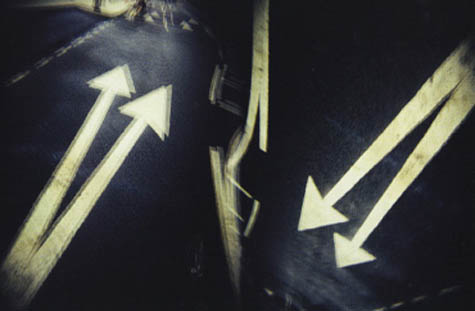 [Image: From Unit 21 at the Bartlett, taught by Christine Hawley, A. Ashton, and A. Porter]. [Image: From Unit 21 at the Bartlett, taught by Christine Hawley, A. Ashton, and A. Porter].Commendably, the instructors of 2009's Unit 14 – Stephen Gage, Phil Ayres, and Richard Roberts – do exactly this, including short descriptions of each image; and, as a reader, I hugely appreciate it. For instance, we read: "Max Pringle, Wearable Buildings: Max is following a long standing interest in the boundaries between architecture, furniture design and fashion. This project is part of a 'collection' that proposes a wearable table cloth that is shared between two people." Or this: "Sam McElhinney, Switchable Labyrinths: Sam develops a maze by switching between monocursal labyrinth forms. This is investigated digitally through the creation of intelligent maze forms populated by intelligent agents and then at 1:1 [scale] as an interactive maze." That's it – but at least now I know what Pringle's and McElhinney's projects actually were, and I'm even given a glimpse into a whole suite of other possible ideas – all in less than 40 words. Less than 40 words. As a writer, it feels absurd to be asking that these students be given 40 words' worth of attention, but it's absolutely better than nothing. It's better for the students, better for the readers, and, I'd assume, also better for the school. Put another (and much more cynical) way: when every architecture student in the world today is busy producing vast, triangulated web-structures that sort of sprawl all over the city, for no immediately obvious reason, it is often the idea behind the project (and not, in fact, the rendered visual quality of your bio-, phylo-, viro-, rhizo-, this, that, and the other thing) that will make or break the project in final reviews. Of course, this raises another question, which is: why on earth is everyone currently engaged in architecture producing viral triangular web-nets? But I think that's a conversation for another day. Finally, an expansion of focus on student content like this will almost undoubtedly require more pages in future editions of these catalogs, but I would also urge these publications to step away from heavy, coated paper toward thinner stocks that allow for longer books while hitting the same price-point and actually, in the end, being easier (that is, lighter) to carry. The students would, presumably, appreciate the extra attention – and readers like myself would love to learn more about what they've made. For my own part, I know that, five years ago, it was year-end reviews of student projects, published by Cornell and the AA, that really got me interested in the narrative possibilities of architectural design – and it's a shame to see this aspect of spatial education played down today.
My wife and I are sitting in Sydney International Airport, getting ready to return to Europe – where all sorts of interesting things are scheduled for the next month or so, including the ASAE 2009 conference in Lund, Sweden, and Digital Architecture London, organized by Ruairi Glynn. But we spent the day yesterday touring an underground commercial mushroom farm south of Sydney, walking past endless racks of shiitake mushrooms growing under fluorescent lights, all of it deep inside a disused railway tunnel cutting through the hills of Mittagong (some photos and notes coming soon) – and having gone "adventure caving" through the limestone hollows of New South Wales the day before that. It's an unexpectedly underground ending to our time here in Australia. It's almost impossible to believe, though, that this trip really is over – but six weeks can pass with surprising rapidity. Such is the calendar. (Sorry, again, by the way, for the lack of anything resembling regular posting while I was down here). In any case, some interesting things to read while we fly 22 hours and 45 minutes back to London: — Smithsonian magazine takes a look at ancient cities lost to the seas – in the process, reminding us all that underwater archaeology is easily one of the most interesting things in the world. —Is there an "enormous system of caves, chambers and tunnels... hidden beneath the Pyramids of Giza"? Discovery asks. "Populated by bats and venomous spiders, the underground complex was found in the limestone bedrock beneath the pyramid field at Giza." —The Seasteading Institute will be hosting its second annual conference next month in San Francisco. —A simulated mine roof will allow engineers to predict mine collapse more accurately; you might not be surprised to learn that it is "the only mine roof simulator of its kind." "Using up to 3 million pounds of vertical force and 1.6 million pounds of horizontal force, it offers researchers the chance to test integrity, stability, and performance under simultaneous loads in the vertical and horizontal directions." A simulant underworld. — Danny Wills, whose recently uploaded travel photos appeared in the previous post, has also documented his visit to Mike Tyson's abandoned mansion in Ohio. —There is a tunnel down here in New South Wales that is illuminated inside only by glowworms. — Hadrian's Wall was apparently first built from wood. It only later became the earthwork that it remains, in ruined form, today. —A 6,000-year old building has been discovered in London, on the shores of the Thames, due to the excavatory expansion of Belmarsh Prison. — Archinect's Michael Jackson Monument Design Competition is now underway and looking for your participation. What is the appropriate scale to remember a man who operated on everything possible - from the studied renovation of his own human form to the creation of an architectural-scale wunderkamer at Neverland Ranch? What design proposal can top his own unrealized plans to construct a 50-foot robotic replica of himself that roams the Las Vegas desert shooting laser beams out of its eyes? The impressive judges' panel includes Sam Jacob, Michael Bierut, and Christopher Hawthorne. You have till August 22 to submit. —Is farming a cure for addiction? An experiment in agricultural reform takes root in upstate New York. —Complete with several odd – and quite loud – musical choices, deep-caver and professional engineer Bill Stone describes his underground adventures... which segues into his intention to build a "gas station" on the moon. Many of his subterranean explorations take him several days – and nearly two miles – beneath the surface of the earth. More links soon! The plane is boarding. (A few of these links were found via the excellent Archaeological News service of Archaeology magazine and via twitter.com/johncoulthart).
 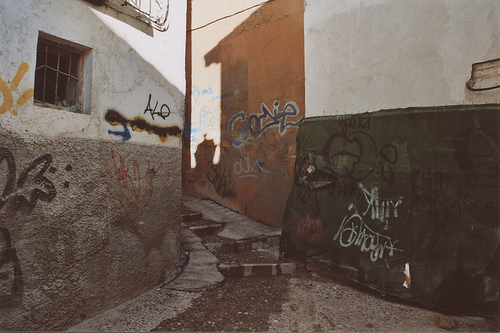 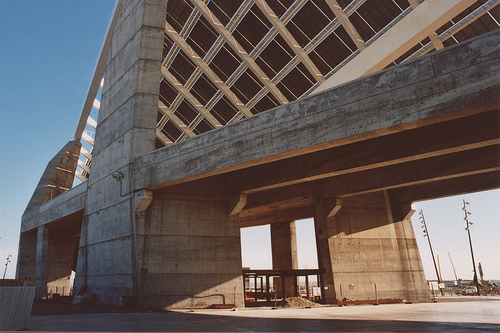 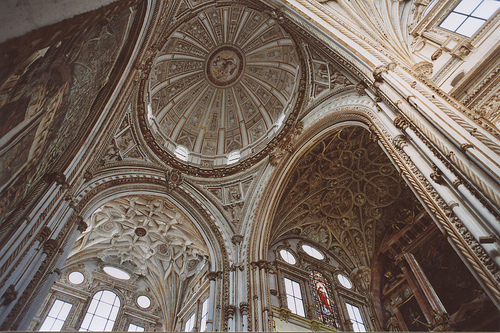  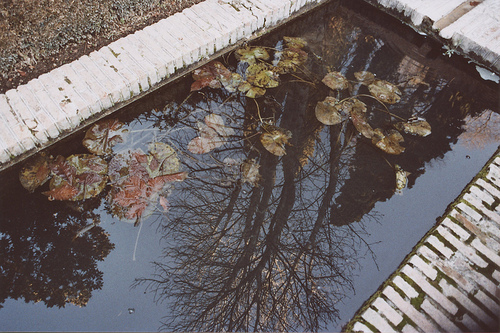 [Images: Six photographs by Danny Wills, from the often awe-inspiring sets of 475 and 194 images that he has uploaded within the past 48 hours, all taken during his recent travels through Spain; there is some great work up there]. [Images: Six photographs by Danny Wills, from the often awe-inspiring sets of 475 and 194 images that he has uploaded within the past 48 hours, all taken during his recent travels through Spain; there is some great work up there].
Omnivoracious, the Amazon.com editors' blog, has just posted a relatively long interview with BLDGBLOG about The BLDGBLOG Book – and I think it turned out really well, in fact. If you're new to BLDGBLOG, or if you simply want to know more about the motivation behind this site or The BLDGBLOG Book, then it might be worth checking it out. From Franz Kafka to prison break films, haunted house novels to the effects of weathering on high-tech materials, Norse myths to Los Angeles traffic jams, artificial glaciers to the overlooked spatial opinions of private parking attendants, the interview really seems to run the list of things I've been trying to focus on here. A brief excerpt: For instance, what do janitors or security guards or novelists or even housewives – let alone prison guards or elevator-repair personnel – think about the buildings around them? What do suburban teenagers think about contemporary home design, when their own bedrooms are right next door to their parents – or what do teenagers think about urban planning, when they have to drive an hour each way to get to school? These sorts of apparently trivial experiences of the built environment are often far more important to hear about than simply learning – yet again – how a certain architect fits him- or herself into a self-chosen design lineage.
So perhaps we should stop talking to Frank Gehry and start interviewing valet parkers in Los Angeles – or crime novelists, or SWAT team captains. They all have an opinion about the built environment, and about the way that cities function, but no one tends to ask them what those opinion might be. If you get a chance, check it out – and if you haven't picked up a copy of The BLDGBLOG Book yet, definitely consider ordering one soon. And thanks!
Earlier this week I stumbled across a series of genuinely beautiful architectural prints by Nathan Freise. These were first exhibited back in July 2008 at New York's School of Visual Arts, and it would have been a real treat to see them in person. 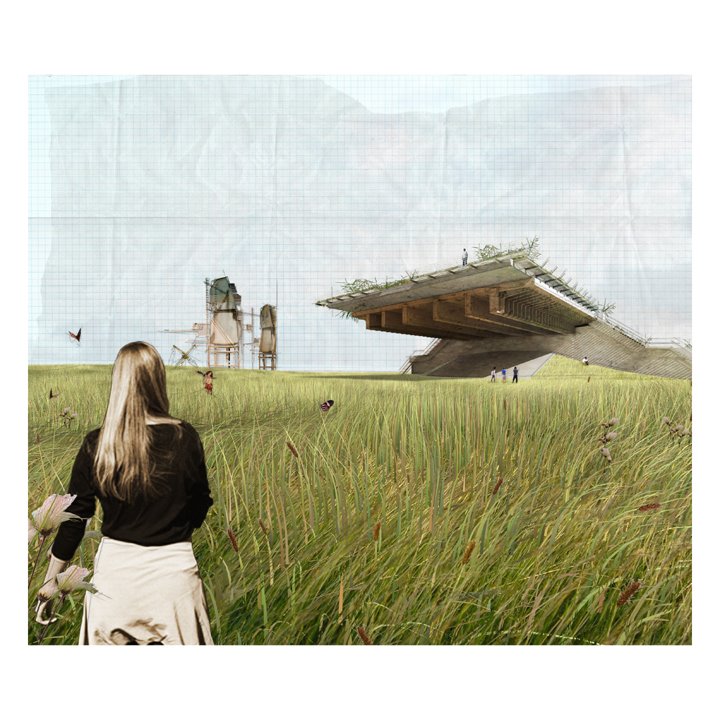 [Image: "The Garden of Machines" by Nathan Freise, from his extraordinarily well-produced Unseen Realities series; perhaps it's Andrew Wyeth meeting the U.S. interstate highway system in a world art-directed by Guillermo del Toro]. [Image: "The Garden of Machines" by Nathan Freise, from his extraordinarily well-produced Unseen Realities series; perhaps it's Andrew Wyeth meeting the U.S. interstate highway system in a world art-directed by Guillermo del Toro].Nathan, of course, is the brother of Adam, and the two of them together – as the Freise Brothers – also directed a short film called The Machine Stops, whose website is also worth a visit if you get the opportunity.  [Image: "The Garden of Machines (Dwell)" by Nathan Freise, from Unseen Realities; this one brings to mind some 22nd-century Charles Darwin watching the machine-birds of tomorrow's eco-motorways, where billboards become breeding grounds for species we've never seen before]. [Image: "The Garden of Machines (Dwell)" by Nathan Freise, from Unseen Realities; this one brings to mind some 22nd-century Charles Darwin watching the machine-birds of tomorrow's eco-motorways, where billboards become breeding grounds for species we've never seen before].The specific images here are described as follows: Freise’s series of inkjet prints depict experimental architecture projects. His hybrid illustrations combine multiple forms of media – ink, graphite, photography and marker – with computer graphics. Freise’s representations of utopian worlds question our current conditions of suburban sprawl and urban master-planning. They are absolutely worth checking out in their original, full size; click through to the Freise Brothers' website and open them in their full, 1000-pixel glory. 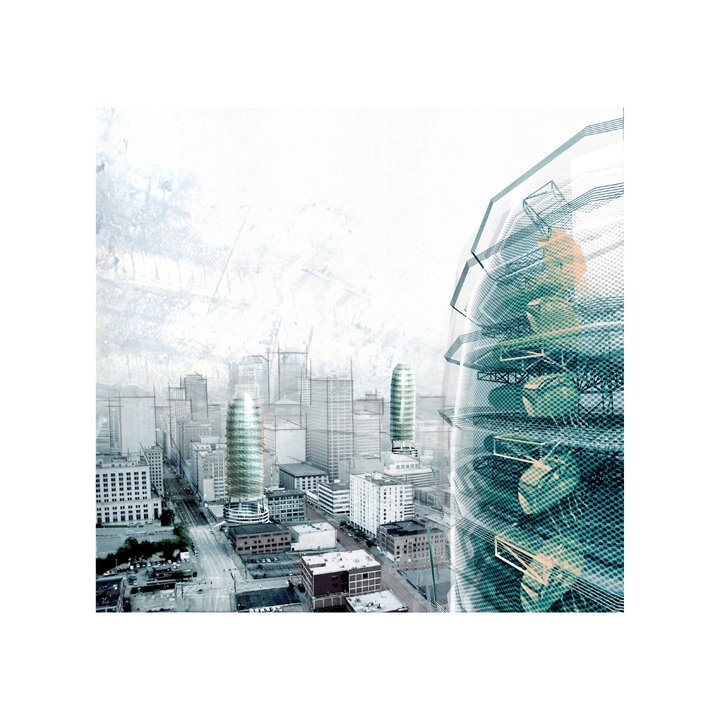 [Image: "Transience (The Nomads)" by Nathan Freise, from Unseen Realities]. [Image: "Transience (The Nomads)" by Nathan Freise, from Unseen Realities]. What I like so much about these is not just their technical quality but their combination of pastoral, near-Edenic landscapes with semi-unconstructed megastructures straight out of scifi. Technicolor screenprints of the architectural future! A new Hudson River School arises, in which the flowering concrete foundations of incomprehensible buildings can be seen, scattered throughout the wild valleys, glinting with fragments of steel as the sun goes down. 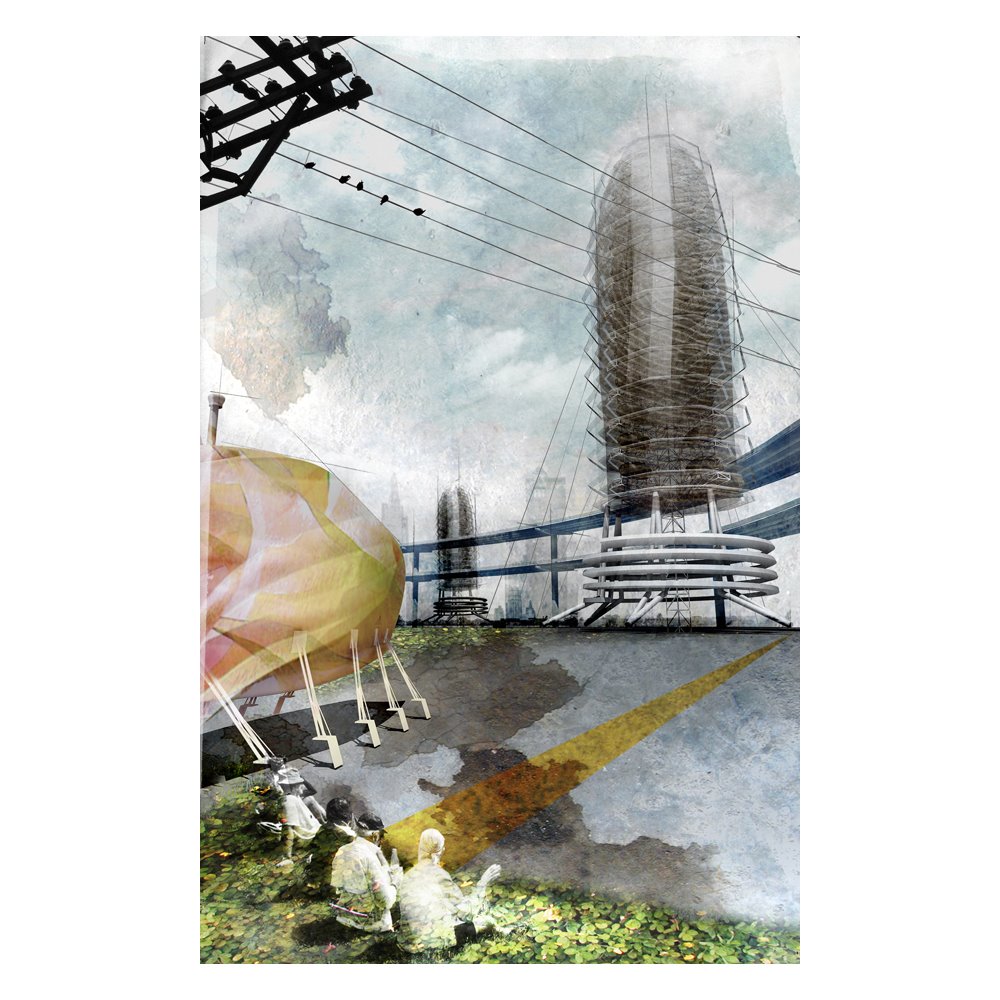 [Images: "Transience (Decay and Renewal)" by Nathan Freise, from Unseen Realities]. [Images: "Transience (Decay and Renewal)" by Nathan Freise, from Unseen Realities].In any case, hopefully someday someone will commission him to make more.
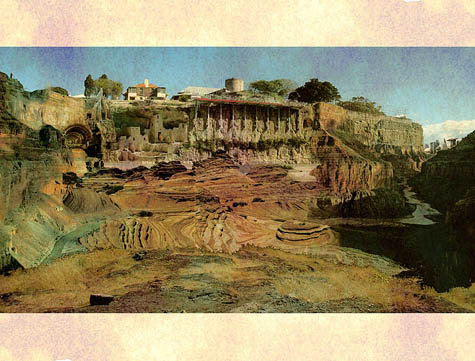 [Image: From Sean Regan's final project at Urban Islands 2009]. [Image: From Sean Regan's final project at Urban Islands 2009].For his final project at Urban Islands – hosted the other week in Sydney and previously discussed here, here, here, here, and elsewhere – Sean Regan produced a heavily-illustrated fake article for a distant-future issue of National Geographic.  [Image: Image and text from Sean Regan's final project at Urban Islands 2009]. [Image: Image and text from Sean Regan's final project at Urban Islands 2009].Piecing together found imagery to create his own narrative exploration of Cockatoo Island, Sean addressed the following question: What would happen to the island if it was no longer historically preserved but deliberately, often violently, altered by the tourists who came to visit it? 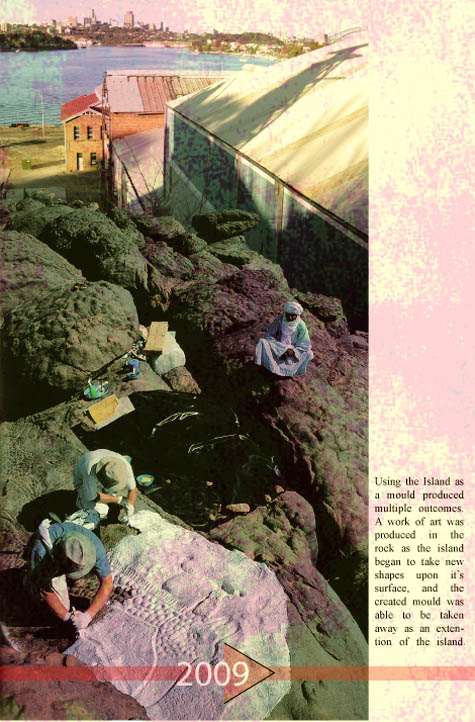  [Images: From Sean Regan's final project at Urban Islands 2009]. [Images: From Sean Regan's final project at Urban Islands 2009].That is, what if tourists were given a more or less complete freedom to carve, excavate, blast, construct, drill, tunnel, and alter their way across the island landscape?  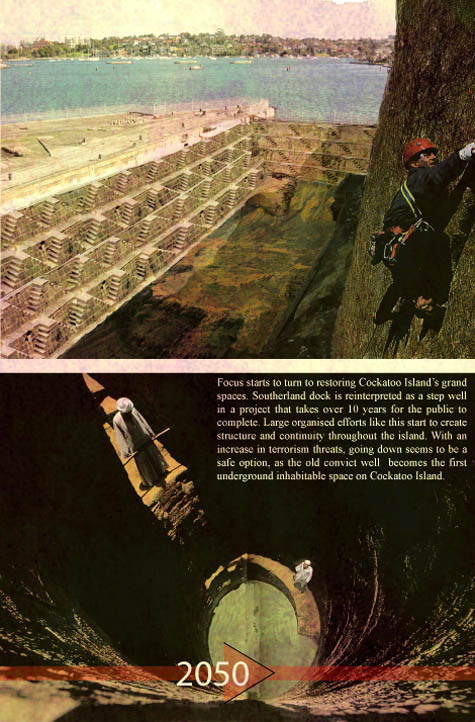 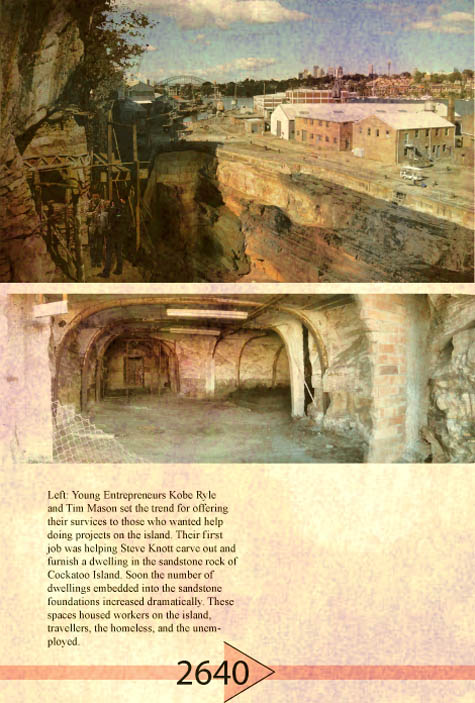 [Images: From Sean Regan's final project at Urban Islands 2009]. [Images: From Sean Regan's final project at Urban Islands 2009].Because of the nature of the studio itself – which was based around the idea of random program generation through the design and distribution of Cockatoo Island-themed "Tarot" cards – this would take the specific form of tourists being handed a series of cards upon arrival at the island. On these cards would be actions, sites, tools, materials, and so on that the visitors would be free to interpret – acting out their conclusions in physical form through often drastic and completely unregulated interventions into the structure of the island itself. 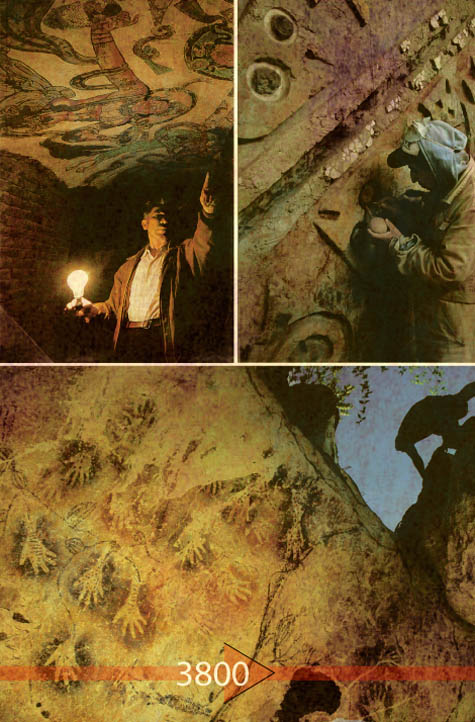 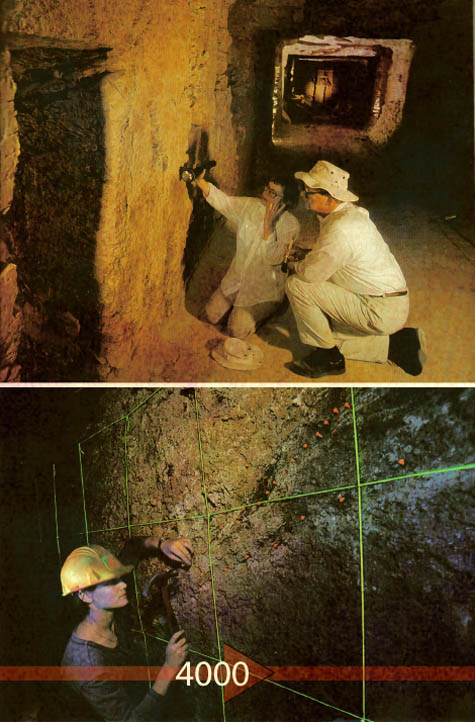 [Images: From Sean Regan's final project at Urban Islands 2009]. [Images: From Sean Regan's final project at Urban Islands 2009].Over thousands of years, then, Cockatoo Island would be transformed through tourist excavations into an increasingly subterranean mazescape of new, improvised passageways – think of it as a kind of geotechnical free jazz, burrowing its way through new forms and structures of geology. The walls themselves become gradually covered in post-aboriginal myths and cave paintings, and anthropologists from around the world come to Sydney to study the altered massing of Cockatoo. It was pointed out in the final studio crit, as exhaustively documented by fellow participant Nick Sowers over on Archinect, that this sort of anything-goes approach to managing Cockatoo Island's future is diametrically opposed to the strange and disappointing historical stasis in which the island is currently trapped. The island needn't be frozen in place, in other words, becoming a museum of its last role (an industrial shipbuilding yard); it could, in fact, be endlessly transformed, over decades, centuries, and even thousands of years, to become a palimpsestic reduction of eras, needs, and fleeting intentions. After all, it was pointed out, that's exactly what Cockatoo is already: a delirium of excavations. It is sliced through with tunnels. Its cliffsides are artificial. Its shorelines have been expanded. Its native species have been replaced. But it's as if Cockatoo's preservationists have been saying, "We will celebrate this island... by transforming it into the very thing it is has never been: static." In this context, perhaps Sean's project isn't merely a speculative fantasy of permanent excavation – proposing a future state of geological amnesia in which constant, superficial erasure reacts mindlessly to the past – but a necessary demonstration of how historic preservation often fails to reveal the very essence of the sites it seeks to celebrate. 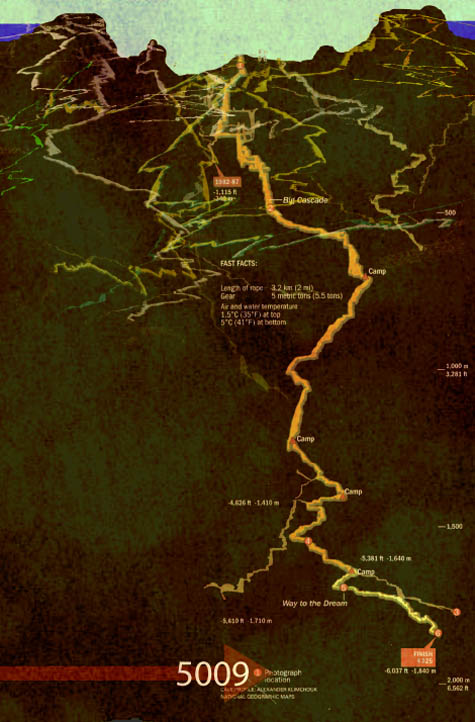 [Image: Cockatoo Island is now a warren of artificial caves extending for kilometers into the earth's surface below. From Sean Regan's final project at Urban Islands 2009]. [Image: Cockatoo Island is now a warren of artificial caves extending for kilometers into the earth's surface below. From Sean Regan's final project at Urban Islands 2009].In any case, the sandstone plateau of the island, the project suggests, will eventually be scraped away to levels far below the waves of Sydney Harbor, requiring the construction of massive ring dams to hold back the sea. The entire island is thus placed into a state of dry dock. By the year A.D. 5009, Cockatoo is nothing more than an opening into the underworld, the island's terrestrial presence having been replaced with the thousands of tunnels now spiraling away into the earth below. Of course, the images that appear here have been deliberately aged to look as if they were found in an excavation several thousand years from now, but Sean's collaging skills, disguised beneath those stains and discolorations, are extraordinary. It was a genuine pleasure to watch this project take shape over the second half of our two-week studio.
|
|
 A related book – Digital Architecture: Passages Through Hinterlands – edited by Glynn and documenting the parallel exhibition, will be released the same day.
A related book – Digital Architecture: Passages Through Hinterlands – edited by Glynn and documenting the parallel exhibition, will be released the same day. [Images: Two projects from the Hinterlands exhibition: (left) MatArc by Patrick Usborne, (right) Crackology by Mayhem].
[Images: Two projects from the Hinterlands exhibition: (left) MatArc by Patrick Usborne, (right) Crackology by Mayhem].
 This weekend in Lund, Sweden, Sir Peter Cook and Abelardo Gonzalez will be hosting the 2009 ASAE conference, the theme of which is
This weekend in Lund, Sweden, Sir Peter Cook and Abelardo Gonzalez will be hosting the 2009 ASAE conference, the theme of which is 
 [Image: From
[Image: From  [Image: From Jared Tarbell's
[Image: From Jared Tarbell's 
 [Images: From Chris Delay's
[Images: From Chris Delay's  [Image: From
[Image: From  [Image: From Chris Delay's
[Image: From Chris Delay's  [Image: By
[Image: By  [Image: From Marco Corbetta's Structure].
[Image: From Marco Corbetta's Structure]. [Image:
[Image:  [Image:
[Image:  [Image: President Nixon addresses
[Image: President Nixon addresses  [Image: "Fear of Flu" by
[Image: "Fear of Flu" by  [Image: Cages for the laboratory testing of rats and mice by
[Image: Cages for the laboratory testing of rats and mice by  [Image: A poster for
[Image: A poster for  [Image: Australian
[Image: Australian  [Image:
[Image: 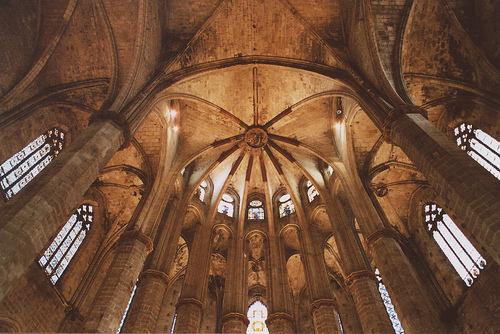



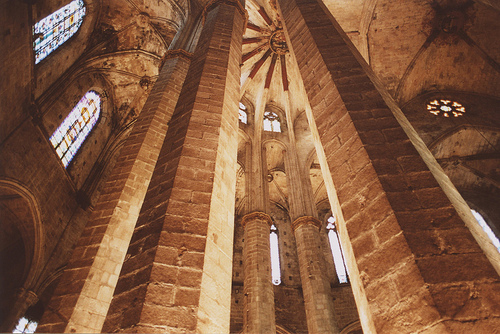
 [Images: All photos by
[Images: All photos by  [Image: A parking meter photographed by
[Image: A parking meter photographed by  [Image: "Lightning Bugs in York, PA," by
[Image: "Lightning Bugs in York, PA," by  [Image: Bioluminescent billboards on one of the Galapagos Islands, by Octave Perrault].
[Image: Bioluminescent billboards on one of the Galapagos Islands, by Octave Perrault]. [Image: Bioluminescent billboards by
[Image: Bioluminescent billboards by  [Image: A map of the
[Image: A map of the  [Image: A bioluminescent tobacco plant, via
[Image: A bioluminescent tobacco plant, via  [Image: Inside
[Image: Inside  [Image: From
[Image: From  [Image: Unidentified student work from
[Image: Unidentified student work from  [Image: From
[Image: From 




 [Images: Six photographs by
[Images: Six photographs by  [Image: "The Garden of Machines" by Nathan Freise, from his extraordinarily well-produced
[Image: "The Garden of Machines" by Nathan Freise, from his extraordinarily well-produced  [Image: "The Garden of Machines (Dwell)" by Nathan Freise, from
[Image: "The Garden of Machines (Dwell)" by Nathan Freise, from  [Image: "Transience (The Nomads)" by Nathan Freise, from
[Image: "Transience (The Nomads)" by Nathan Freise, from  [Images: "Transience (Decay and Renewal)" by Nathan Freise, from
[Images: "Transience (Decay and Renewal)" by Nathan Freise, from  [Image: From Sean Regan's final project at
[Image: From Sean Regan's final project at  [Image: Image and text from Sean Regan's final project at
[Image: Image and text from Sean Regan's final project at 
 [Images: From Sean Regan's final project at
[Images: From Sean Regan's final project at 

 [Images: From Sean Regan's final project at
[Images: From Sean Regan's final project at 
 [Images: From Sean Regan's final project at
[Images: From Sean Regan's final project at  [Image: Cockatoo Island is now a warren of artificial caves extending for kilometers into the earth's surface below. From Sean Regan's final project at
[Image: Cockatoo Island is now a warren of artificial caves extending for kilometers into the earth's surface below. From Sean Regan's final project at 


